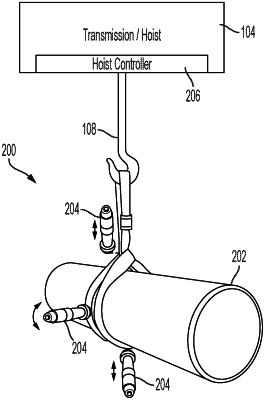| CPC B66C 13/24 (2013.01) [B66C 13/16 (2013.01)] | 19 Claims |

|
1. A zero-gravity hoist system, comprising:
a chain fall;
a motor coupled to the chain fall, and configured to drive the chain fall in one or more directions;
a power supply configured to provide power to the motor;
a load sensing assembly configured to determine a force of a load attached to the chain fall, wherein the load sensing assembly includes:
a spring plate configured to deflect in response to a variation in the force of the load, wherein the spring plate includes a conductive surface configured to receive a first signal; and
an antenna configured to receive a second electrical signal from the first conductive surface; wherein the second electrical signal is associated with a distance between the antenna and the conductive surface, the antenna configured to generate an output based on the received second electrical signal; and
a controller having one or more electronic processors, wherein the one or more electronic processors are configured to:
receive an input from a user indicating that the load coupled to the chain fall is at a desired height;
receive a first output from the antenna;
measure a first force of the load in response to receiving the input and based on the received first output;
store the measured force in a memory of the controller;
receive a second output from the antenna;
measure a second force of the load based on the received second output;
determine a difference between the second measured force and the first measured force; and
adjust the height of the load based on determining that the second force differs from the first force by a predetermined threshold.
|